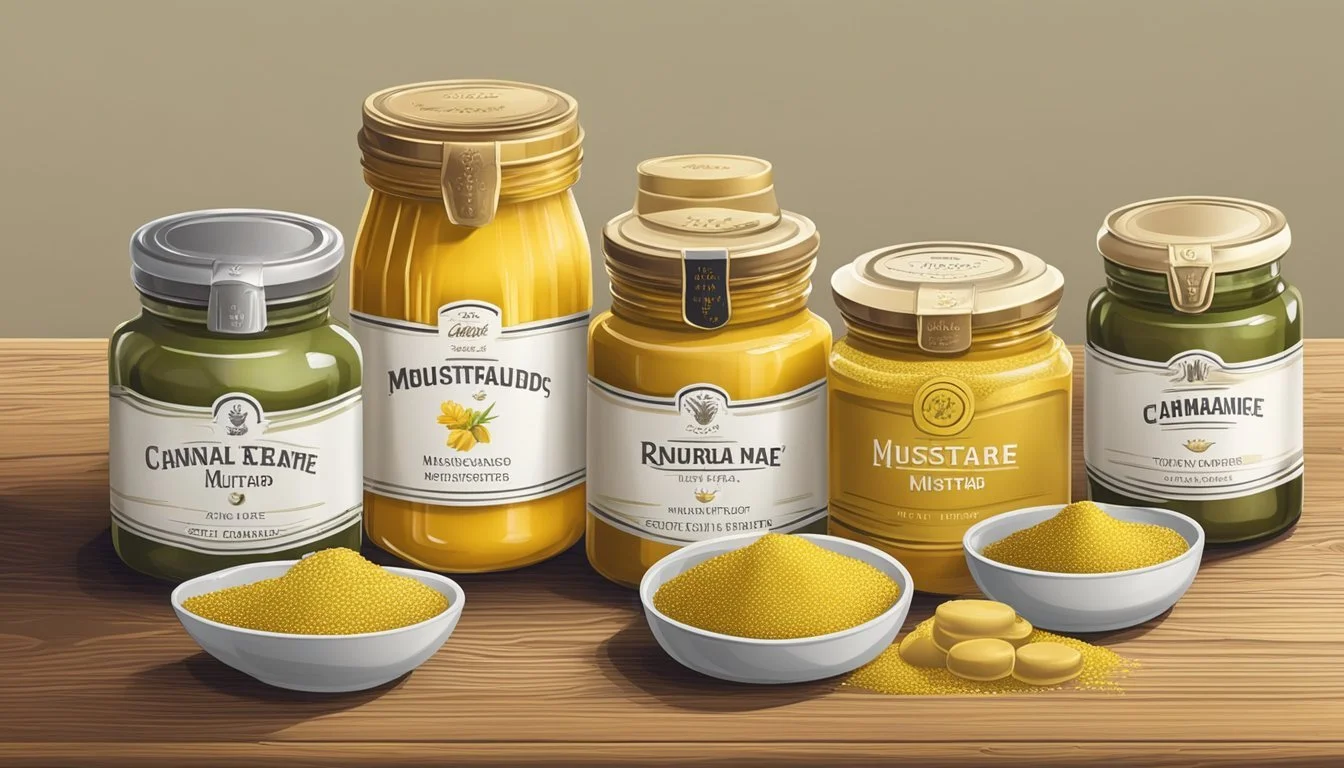Champagne Mustard Substitutes
Top Alternatives for Your Recipes
Champagne mustard, known for its smooth texture and distinctive flavor that adds a gourmet touch to sandwiches and dressings, can sometimes pose a challenge for those looking to replicate its characteristics without the original ingredient. Crafted from the seeds of mustard plants and combined with the effervescence of champagne, this condiment is not only a favorite for its taste but also for its absence of gluten and high-fructose corn syrup.
Nevertheless, there are occasions when champagne mustard may not be readily available or when dietary restrictions call for an alternative. In such cases, substitutes must be considered to achieve a similar balance of tanginess and texture. Options range from using other types of vinegars for their acidity to employing various condiments that offer an analogous mouthfeel and flavor intensity.
Understanding Champagne Mustard
Champagne Mustard is a luxurious condiment known for its distinct flavor profile and versatility in culinary applications.
Origins and Flavor Profile
Origins: Champagne Mustard originates from the incorporation of champagne into traditional mustard recipes. This practice adds a level of sophistication to the mustard's flavor.
Flavor Profile: It boasts a unique taste that is both tangy and flavorful, with a hint of the fermented grapes' acidity from the champagne. Unlike regular mustards, which can be pungent, Champagne Mustard typically presents a more subtle and refined taste experience.
Culinary Uses
Versatility: It is frequently used as a spread, glaze, or dipping sauce.
Impact on Dishes: In the culinary context, Champagne Mustard provides a delicate balance of tang and zest, making it an excellent accompaniment for meats, cheeses, and dressings. Its inclusion in recipes often enhances the overall savoriness without overpowering other ingredients.
Champagne Mustard enriches dishes with its unique blend of mustard's familiar tanginess and the sophisticated notes of vinegar and champagne.
Common Mustard Types and Their Characteristics
In the diverse world of mustards, each type stands out with its unique taste, texture, and culinary uses. They range from sweet and mild to spicy and pungent, rooted in their particular combinations of mustard seeds and varying additional ingredients.
Dijon Mustard
Dijon Mustard originates from Dijon, France, and is known for its creamy consistency and sharp, strong flavor. This variety typically uses brown or black mustard seeds and white wine, which contribute to its distinct taste. The inclusion of spices can enhance its complexity, making it suitable for vinaigrettes and marinades.
Honey Mustard
Honey Mustard offers a sweet and tangy flavor profile, balancing the pungency of mustard with the smoothness of honey. It's made by combining honey with Yellow Mustard, using a 2:1 ratio of honey to mustard, imparting a milder taste that is ideal for dressings or as a dipping sauce.
Yellow Mustard
Yellow Mustard, one of the most common and mild types, is characterized by its bright yellow color, courtesy of added turmeric. This variant uses white mustard seeds and has a milder, less pungent flavor. Its tangy yet not overpowering nature is a perfect companion for classic American hot dogs and burgers.
Spicy Brown Mustard
Spicy Brown Mustard is recognized by its coarser texture and spicy kick, a result of using less finely ground brown mustard seeds and fewer or no spices. The robust flavor profile of this mustard makes it a favorite for deli sandwiches and can complement richer meats well.
Whole Grain Mustard
Whole Grain Mustard typically mixes whole mustard seeds with vinegar, and possibly white wine, to form a thick, rustic texture with a pungent flavor. The intact seeds provide bursts of flavor and are visually appealing, making it not only a flavorful addition to meats and cheeses but also a textural element in sauces and dressings.
Mustard Substitutes Overview
When seeking to replace champagne mustard, one must take into account the unique tangy taste and slight wine essence it imparts. The right mustard substitute should offer a similar balance of flavor and complexity.
Factors to Consider When Substituting
Flavor Profile: A substitute for champagne mustard needs to have a balance between tanginess and a hint of sweetness. White wine vinegar can often provide a similar acidic note, though it lacks the mustard's texture. A blend of dry mustard and a touch of honey or sugar can emulate champagne mustard's flavor more closely.
Dietary Restrictions: For those with dietary concerns, it's crucial to select a mustard substitute that aligns with their needs. Some alternatives like mayonnaise might not be suitable for vegans, while horseradish could be too intense for those with sensitive palates.
Condiments: Many condiments like mayonnaise and horseradish are often used in place of mustard to maintain texture in recipes. It is essential to adjust the quantities appropriately as these substitutes can vary widely in taste intensity.
Dry Mustard: If dry mustard is available, it serves as an excellent base for creating a champagne mustard alternative. By adding a splash of wine, vinegar, or even fruit juice, one can adjust dry mustard to more closely mimic the original condiment's wine-infused flavor.
Dairy-Based Substitutes
When replacing Champagne mustard, dairy-based options offer a creamy texture and a tang that can come close to matching the original condiment's rich profile. These substitutes are commonly found in the kitchen and can be customized with additional ingredients like oil, vinegar, or lemon juice to achieve the desired flavor.
Mayonnaise
Mayonnaise stands out as a Champagne mustard substitute due to its creamy consistency and mild flavor. It can serve as a base that can be built upon with:
Oil: to maintain a rich texture
Vinegar: for added tanginess
Lemon juice: for a hint of zest
For dressings and dips that require Champagne mustard, one might consider mixing equal parts of mayonnaise with a bit of vinegar or lemon juice to mimic the mustard's acidity.
Plain Yogurt
Plain yogurt offers a healthier alternative with a similar creamy base and a natural tang. To tailor yogurt closer to Champagne mustard's taste profile, one can add:
Oil: for a smoother consistency
Vinegar: to enhance the sourness
Lemon juice: for a subtle citrus note
The robust flavor of plain yogurt can be adjusted with a small amount of vinegar or lemon juice, creating a suitable replacement for Champagne mustard in most recipes, especially in dressings and marinades.
Vegetable and Fruit-Based Alternatives
When it comes to finding a substitute for champagne mustard, certain vegetables and fruits offer a range of flavors and consistencies that can mimic its unique characteristics. These alternatives provide a different texture while contributing to the overall flavor profile of the dish.
Avocado
Avocado is an excellent fruit-based alternative to champagne mustard in many recipes. It brings a creamy texture and subtle richness that blends well in dressings and dips. To use avocado as a substitute, one should mash it until smooth and consider balancing the creaminess with a splash of apple cider vinegar for tanginess, resembling the sharpness of mustard.
Proportion: Use a 1:1 ratio of mashed avocado to the amount of champagne mustard required.
Acidity Adjustment: Add apple cider vinegar to taste, starting with a small amount, such as a teaspoon for every half cup of mashed avocado.
Applesauce
Applesauce serves as another suitable substitute, particularly in baked goods, where it can replace champagne mustard to maintain moisture and add a sweet note to the recipe. It is important to use unsweetened applesauce to control the sugar content and to approximate the mild flavor of champagne mustard more closely.
Unsweetened: Opt for unsweetened applesauce to avoid an overly sweet flavor.
Water Content: If the applesauce is too thin, reduce the amount of liquid elsewhere in the recipe to compensate for the extra water content.
By utilizing avocado and applesauce as alternatives, the cook retains the integral moisture and binding properties that champagne mustard would typically provide, while introducing a fresh and nuanced flavor dynamic to the culinary creation.
Other Condiment Substitutes
When champagne mustard is unavailable, one can explore a variety of pungent or tangy condiments that can mimic its unique flavor to some extent. These alternatives not only add zest to your dishes but can be adjusted in intensity to suit your palate.
Horseradish and Horseradish Sauce
Horseradish, a root vegetable known for its fiery flavor, serves as an excellent substitute. It can be grated fresh or used in the form of horseradish sauce, which often has vinegar and cream, balancing the sharpness. It's important to start with small quantities to gauge the heat.
Wasabi
Wasabi, similar to horseradish, offers a sharp, sinus-clearing intensity. It's commonly used in Japanese cuisine and is available as a paste or powder. Wasabi should be used sparingly due to its potency, to not overpower the flavors of your dish.
Sauces and Dressings
Various sauces and dressings can replace the tangy and somewhat sweet profile of champagne mustard in recipes:
Worcestershire sauce: This fermented condiment brings in a complex, savory flavor but lacks mustard's heat.
Barbecue sauce: For a smoky twist, barbecue sauce can be a flavorful stand-in, especially in marinades and glazes.
Sriracha: This chili-based sauce adds both heat and a hint of sweetness, perfect for giving dishes a spicy kick.
In contrast, ketchup might seem like a common staple, but its sweetness and mild tang could complement other ingredients in a pinch, especially in dressings or as a component in homemade sauces. However, its flavor profile is quite different from that of champagne mustard.
One must take care to adjust these alternatives to their taste preference, as each has a distinct flavor and spice level.
Homemade Mustard Alternatives
Creating your own mustard alternative at home is a straightforward process that lets you adjust flavors to your preference. All you need is a base of mustard seeds or mustard powder, and from there you can add various ingredients such as vinegar, spices, and oils.
Creating Custom Flavors
Mustard Seeds or Powder: The foundation of homemade mustard is either mustard seeds or mustard powder. Mustard seeds can be soaked in water and then ground for a fresher taste, while mustard powder offers a quick and convenient option.
Vinegar: Vinegar is crucial to the flavor and preservation of homemade mustard. White vinegar lends a traditional sharpness, but experimenting with apple cider, wine, or balsamic vinegar can add unique undertones to your sauce.
Spices: Here’s a basic combination to get you started, but feel free to experiment:
1 tsp salt for seasoning
½ tsp sugar to balance acidity
A pinch of turmeric for color and earthiness
Garlic powder, paprika, or dill for additional flavors
Oils: The choice of oil can influence the consistency and taste of your mustard. Olive oil gives a fruity note, while vegetable oil is neutral and allows other flavors to stand out.
Table 1: Basic Homemade Mustard Recipe
Ingredient Quantity Mustard seeds/powder 1 cup Vinegar (of choice) ¾ cup Salt 1 tsp Sugar ½ tsp Selected spices To taste Olive/Vegetable oil 2 tbsp
Procedure:
If using seeds, soak them in vinegar overnight. If using powder, mix it directly with the vinegar.
Blend the seeds/powder and vinegar with salt, sugar, and chosen spices until smooth.
Gradually add the oil while blending until the desired consistency is reached.
Taste and adjust the seasonings as necessary. Store in a sealed container in the refrigerator.
Utilizing Mustard Substitutes in Recipes
In the absence of champagne mustard, various other ingredients can effectively complement and enhance the flavors in different types of dishes. Each substitute should be chosen based on the flavor profile and texture desired in the recipe.
Meat Dishes
When preparing meat dishes, a common substitute for champagne mustard as a glaze can be honey mustard. To create a similar depth of flavor, one can mix honey and a milder mustard, such as yellow mustard, in a 2:1 ratio. This blend offers a sweet and tangy taste that pairs well with pork and chicken. For preparing marinades, mayonnaise combined with a touch of vinegar can be used; it provides the necessary acidity and creaminess, and is especially suitable for tenderizing and flavoring meat.
Pork and Chicken Glazes:
Honey Mustard (2:1 ratio to mustard)
Mayonnaise + Vinegar (adjust to taste)
Vegetarian and Vegan Dishes
For vegetarian and vegan dishes that typically rely on mustard for a punchy flavor in vinaigrettes or as an emulsifier in dressings, one can use white vinegar or prepared horseradish. White vinegar ensures the vinegar flavor and acidity that is desirable, while horseradish provides a spicy kick. Both should be used sparingly and to taste, as they have a more pronounced flavor profile than champagne mustard.
Vinaigrettes:
White Vinegar (start with a small amount and adjust)
Prepared Horseradish (use sparingly)
Salad Dressings and Marinades
In salad dressings and marinades, substitutes like mayonnaise for creaminess or wasabi for a hint of heat can be used in small amounts to replicate the tangy and piquant notes of champagne mustard. Incorporating vegetable oil can help in achieving a smoother consistency if the dressing becomes too thick with the substitute. For a sandwich spread or dip, mayonnaise remains a versatile option, allowing for adjustments in flavor with the addition of herbs and spices.
Salad Dressings:
Mayonnaise (use as base; add herbs/spices to taste)
Wasabi (add cautiously for heat)
Marinades:
Vegetable Oil (to adjust consistency)
White Vinegar or Wasabi (for flavor; use sparingly)
In all instances, substituting champagne mustard requires careful consideration of flavor balance. Adjustments should be made in increments to ensure the desired outcome is achieved.
Additional Considerations
When looking for Champagne mustard substitutes, one needs to consider the impact of allergies, dietary restrictions, and the storage needs of alternative ingredients. These factors play a critical role in maintaining a safe and enjoyable dining experience.
Allergy and Dietary Restrictions
Champagne mustard may pose concerns for individuals with allergies to certain seeds or ingredients. It's imperative to understand the dietary restrictions of those who will be consuming the dish. For instance, individuals with a mustard allergy should avoid mustard-based substitutes, opting instead for allergy-safe alternatives.
Vinegar Mixtures: A combination of white vinegar, water, and a pinch of sugar can be a viable replacement while accommodating for certain dietary restrictions.
Wasabi or Horseradish: Both are related to mustard but may still trigger allergies; use with caution.
Note: Vegan diners might require a substitute free from honey, whereas some dishes may need to be modified to prevent gluten exposure.
Shelf Life and Storage
The longevity and safe storage of Champagne mustard substitutes are also worth noting. Various alternatives come with different shelf lives and storage recommendations, which can impact the practicality of their use.
Mayonnaise: Typically refrigerated with a shelf life ranging from a few weeks to months after opening.
Vinegars: Can be stored at room temperature and have a long shelf life, often extending several years when sealed properly.
To ensure freshness and avoid spoilage, one should always check expiration dates and adhere to recommended storage practices for each substitute.











